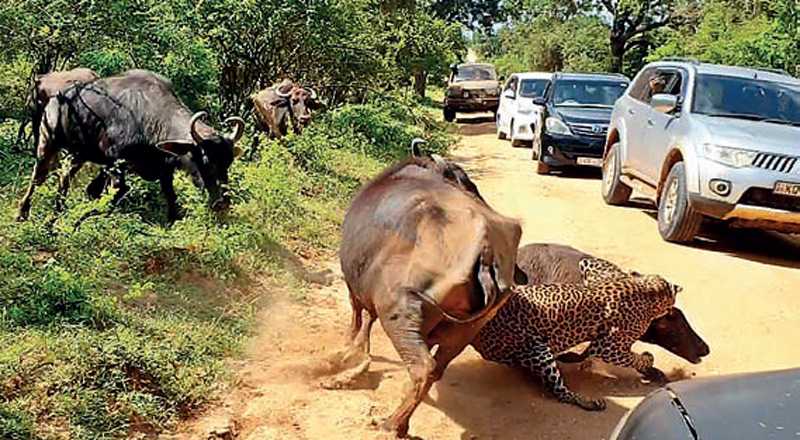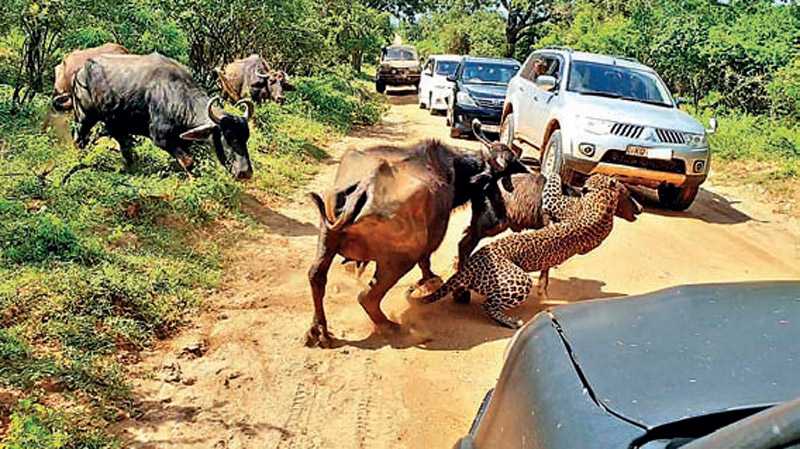Thursday Jan 15, 2026
Thursday Jan 15, 2026
Friday, 12 February 2021 00:00 - - {{hitsCtrl.values.hits}}

By Rohan Wijesinha
Last week, a video went viral, on all forms of social media, showing a leopard escape the wrath of a herd of buffalo when it attempted to snatch a young calf from their midst.
This remarkable and rare piece of footage, taken by a fortunate visitor to the Yala National Park, showed a male leopard attempt to grab a calf from the buffalos’ midst and get immediately, and ferociously, set on by the angry bovines, intent on protecting their own.
The leopard finally had the good sense to let go of its potential meal for sake of survival, and was chased up a tree by the livid buffalos. It was lucky to get away with just the superficial wounds that it seemed to have sustained. Had he missed his footing and stumbled, and the buffalo got to him, especially against a tree, he may not have lived to learn from the error of his ways.
Leopards do predate on buffalo calves, by stalk and strategy, but rarely do they attempt it so boldly from the midst of a group of these half ton beasts whose horns can slash through muscle and sinew.
Wonder… on wonder…
Apart from this amazing audio-visual capture, the fact that it was probably the most shared video of the week, and broke records for ‘hits’ and ‘shares’ on most conservation group sites, locally and internationally, show how powerful are the natural wonders of nature in stimulating the interest and passions of people, especially if filmed in the wilderness, of animals behaving as they normally would, wild and free.
Any potential wildlife lover, the world over, would wish to have been in the place of the lucky person who filmed this, to see such a rare and exciting event unfold before their very eyes. And this is just one event, in one protected area of Sri Lanka. This country is blessed with so many more.
…but for how long more?
Yes, it is still possible to see such wondrous events in Sri Lanka’s National Parks and protected areas, but for how long more? Where once the main crisis for conservation was the human-elephant conflict, it has now spread to that of human-wildlife crises.
This has been brought about by unplanned, politically short-sighted development that has resulted in the destruction of once pristine habitat that was home for these wild creatures.
Inevitably, in their quest for survival, for food and shelter, they must now increasingly run the gauntlet of entering human habitations that were once exclusively their own. They are then cast as the villains and killed, sometimes in the most brutal of ways.
Last year saw a record number of leopards killed, including a rare black leopard; most were caught in snares that either slowly strangled them to death, or if still found alive, died soon after as the steel wires crushed their internal organs beyond medical repair. Most of these killings have been targeted attacks, with the body parts of the animals removed for their supposed medicinal properties.
It should be remembered that the Sri Lankan Leopard, Panthera pardus kotiya, is a sub-species unique to this country, classified as endangered on the Red List of the IUCN, and should be fiercely protected for posterity.
We need them
Sri Lanka is the one place in the world that leopards may be seen during the day and is why visitors, especially foreign, flock to the Yala and Wilpattu National Parks. 39% of all foreign visitors to this country visit one of the National Parks. In 2016, the Yala National Park generated an estimated Rs. 7 billion for the country’s economy (SLAITO Report).
Leopards are apex predators and do not have to compete with lions, tigers and hyenas as do their counterparts in the other countries that host them. They have only man to fear; unless they have the mistaken temerity to charge into the midst of a herd of buffalo to snatch one of their own.
Sri Lanka needs development, planned development, and the understanding that wildlife, if protected and conserved, are an important, and sustainable, source of foreign exchange to this country. Regrettably, with increased deforestation taking place, on the whims of those in power, and with no thought to the long-term consequences of their action or that of future generations, human-wildlife conflict is only going to increase, with casualties on both sides.
It must here be remembered that one of the most important functions of the Department of Wildlife Conservation is the protection of most of the major water catchment areas of this country. No forests, then no rain. No rain, then no water. No water, then no life – wild or human.
This present carnage must stop before irreversible damage is done to the environment, and to all species it supports, including us humans. It is said that a leopard cannot change its spots… can we?
-Pix courtesy screen grabs from video by Ravindu Sahimal


(The writer is a former General Secretary of the Wildlife and Nature Protection Society and Editor of WNPS Journal, Loris and Trustee of FEO.)